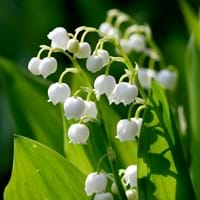Life Span
Biennial and Perennial
Perennial
Type
Vegetable
Flowering Plants
Origin
Europe, Western Asia
Asia, Europe
Types
Not Available
American Lily of the Valley, European Lily of the Valley, Japanese Lily of the valley.
Number of Varieties
Not Available
Habitat
waste ground, wastelands
Banks, Broad-Leaved Forests, coppices, Dry and Young forest Heaths, Forest margins, Ridges, Rocky Ridges
USDA Hardiness Zone
4-9
4-8
Sunset Zone
A1, A2, A3, H1, H2, 1a, 1b, 2a, 2b, 3a, 3b, 4, 5, 6, 7, 8, 9, 10, 11, 12, 13, 14, 15, 16, 17, 18, 19, 20, 21, 22, 23, 24
A1, A2, A3, H1, H2, 1a, 1b, 2a, 2b, 3a, 3b, 4, 5, 6, 7, 14, 15, 16, 17, 18, 19, 20
Habit
Rosette/Stemless
Mat-forming
Flower Color
Yellow
Pink, White
Flower Color Modifier
Bicolor
Not Available
Fruit Color
Brown, Black
Not Available
Leaf Color in Spring
Green
Dark Green
Leaf Color in Summer
Green
Dark Green, Green
Leaf Color in Fall
Green
Green, Yellow green
Leaf Color in Winter
Not Available
Not Available
Leaf Shape
Pinnate
Bell Shaped
Plant Season
Summer
Fall, Spring, Summer
Sunlight
Full Sun
Part sun, Partial shade
Type of Soil
Loam
Moist, Well drained
The pH of Soil
Neutral
Acidic, Neutral
Soil Drainage
Well drained
Not Available
Bloom Time
Summer
Late Spring, Spring
Tolerances
Drought
Not Available
Where to Plant?
Ground, Pot
Container, Ground, Pot
How to Plant?
Seedlings
From Rhizomes, Seedlings
Plant Maintenance
Medium
Medium
Watering Requirements
Average Water Needs, Do Not over Water, Keep the ground moist but not water-logged
Keep the ground moist but not water-logged, Requires a lot of watering, Water twice a day in the initial period, Water when soil is dry
In Summer
Lots of watering
Lots of watering
In Spring
Moderate
Moderate
In Winter
Average Water
Average Water
Soil pH
Neutral
Acidic, Neutral
Soil Type
Loam
Moist, Well drained
Soil Drainage Capacity
Well drained
Not Available
Sun Exposure
Full Sun
Part sun, Partial shade
Pruning
Remove damaged leaves, Remove dead branches, Remove dead leaves
Do not prune during shooting season, Prune after harvesting, Prune in late summer or fall, Prune to stimulate growth, Remove deadheads
Fertilizers
All-Purpose Liquid Fertilizer
All-Purpose Liquid Fertilizer
Pests and Diseases
Aphids, Armyworm, Cutworms, Downy mildew, Pitch canker, Red blotch
Anthracnose, Aureobasidium leaf spot, Foliar nematode, Leaf spot, Mealybugs, Rust, Southern blight
Plant Tolerance
Drought
Drought
Flower Petal Number
Not Available
Not Available
Edible Fruit
No
Not Available
Fragrant Fruit
No
Not Available
Fragrant Leaf
Yes
Not Available
Fragrant Bark/Stem
Yes
No
Foliage Texture
Fine
Coarse
Foliage Sheen
Matte
Not Available
Self-Sowing
Yes
Not Available
Attracts
Butterflies
Bees
Allergy
Stomach burn
Headache, Nausea, Vomiting
Aesthetic Uses
Not Available
Beautification, Showy Purposes
Beauty Benefits
Blood purifying, Good for skin
Not Available
Environmental Uses
Air purification
Air purification
Medicinal Uses
Aphrodisiac
Chest pain, Swelling
Part of Plant Used
Root
Flowers, Leaves, Root
Other Uses
Food for animals, Used as a nutritious food item
Air freshner, Cosmetics, Oil is used for aromatherapy, Oil is used in perfume, soaps, creams, etc., Showy Purposes, Used As Food, Used as Ornamental plant, Used for fragrance
Used As Indoor Plant
Yes
Yes
Used As Outdoor Plant
Yes
Yes
Garden Design
Edible, Herb, Vegetable
Bedding Plant, Bog Garden, Cutflower, Edging, Foundation, Mixed Border
Botanical Name
PASTINACA sativa
Convallaria majalis
Common Name
Parsnip
Lily of the Valley
In German
Pastinake
Maiglöckchen
In French
Panais
Lily of the Valley
In Spanish
Chirivía
Lirio de los valles
In Greek
Είδος δαυκίου
Κρίνος της κοιλάδας
In Portuguese
cherivia
Lírio do Vale
In Polish
Pasternak
Lilia doliny
In Latin
parsnip
Lílium convállium
Phylum
Magnoliophyta
Tracheophyta
Class
Magnoliopsida
Magnoliopsida
Order
Apiales
Asparagales
Family
Apiaceae
Asparagaceae
Clade
Angiosperms, Asterids, Eudicots
Angiosperms, Monocots
Tribe
Not Available
Not Available
Subfamily
Not Available
Nolinoideae
Number of Species
Not Available
Not Available
Season and Care of Parsnip and Lily of the Valley
Season and care of Parsnip and Lily of the Valley is important to know. While considering everything about Parsnip and Lily of the Valley Care, growing season is an essential factor. Parsnip season is Summer and Lily of the Valley season is Summer. The type of soil for Parsnip is Loam and for Lily of the Valley is Moist, Well drained while the PH of soil for Parsnip is Neutral and for Lily of the Valley is Acidic, Neutral.
Parsnip and Lily of the Valley Physical Information
Parsnip and Lily of the Valley physical information is very important for comparison. Parsnip height is 15.20 cm and width 7.60 cm whereas Lily of the Valley height is 6.00 cm and width 1.00 cm. The color specification of Parsnip and Lily of the Valley are as follows:
Parsnip flower color: Yellow
Parsnip leaf color: Green
Lily of the Valley flower color: Pink and White
- Lily of the Valley leaf color: Dark Green
Care of Parsnip and Lily of the Valley
Care of Parsnip and Lily of the Valley include pruning, fertilizers, watering etc. Parsnip pruning is done Remove damaged leaves, Remove dead branches and Remove dead leaves and Lily of the Valley pruning is done Do not prune during shooting season, Prune after harvesting, Prune in late summer or fall, Prune to stimulate growth and Remove deadheads. In summer Parsnip needs Lots of watering and in winter, it needs Average Water. Whereas, in summer Lily of the Valley needs Lots of watering and in winter, it needs Average Water.





